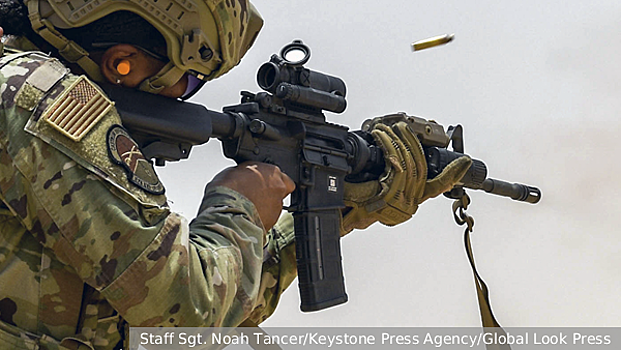M4 assault rifle: how it differs from the famous M16
American automatic carbine, based on the M16A2 assault rifle. It is in service with the US intelligence agencies, army and Marine Corps. Delivered to different countries around the world (more than 60). Used in 15 major wars and several local conflicts. Featured in many movies, video games, and television series. Production and modifications continued.

History of the M4 rifle
After the M16 entered service in 1962, development of a shortened version designed for close combat began. The result was the CAR-15 series of carbines used in the Vietnam War. Within 20 years it had become obsolete and in 1982 Colt received an order to create a modern carbine based on the M16A1E1. Design work was completed by June 1983 and the prototype, designated the XM4 Carbine, was tested by the US Army Armament Research and Development Center.
But the design was deemed not perfect enough so changes were made for another six years. In 1985, Picatinny Arsenal in New Jersey was tasked with producing 40 prototypes for the Army and Marine Corps (MCC). However, a year later, the Army stopped funding the project, so the prototypes were only delivered to the Marines for testing.
Interesting fact: to date, more than half a million carbines of this series have been produced. More than 90 changes were made to the weapon's design, aimed at improving ergonomics and increasing modularity. In 2012, the average cost of a copy was about $700. Three years later, the price dropped to $647. Almost all American arms manufacturers produce their own versions of additional equipment for the M4 (underbarrel grenade launchers, collimators, silencers, etc.).
The 5.56 mm caliber Colt M4 model entered service only in 1994. Mass production was launched at the enterprises of the Colt Manufacturing Company. Gradually, these carbines began to replace military submachine gun models. In 2007, the M4 became the service weapon of all Marine Corps officers (up to the rank of colonel) instead of the Beretta M9 pistol. Since 2010, the process of replacing the M16 with the M4 in the US Army began. Five years later, all Marines were rearmed.
In 2009, the US Department of Defense purchased a patent for the production of this weapon, so all manufacturers received the right to develop their own versions of the carbine on this platform. Two years later, the Army began awarding multimillion-dollar contracts for improved versions of the M4A1 to Colt Firearms, Remington Arms Company, the U.S. subsidiary of Belgian arms manufacturer FN Herstal, and many other companies.
Design features of the M4 rifle
The basic principles laid down by M16 designer Eugene Stoner remain unchanged. The automation operates using a gas drive, uses an air cooling system and is loaded with NATO standard 5.56×45 mm ammunition. But the gun barrel has been significantly redesigned, the length reduced from 510 to 370 mm. The rifle distance remains unchanged (178 mm). The ammunition supply ramps became deeper and the bell at the front became larger. Thanks to that, damage when loading ink cartridges can be minimized.
The receiver is made from forged aircraft-grade aluminum and the bolt carrier is made from steel. The body, forend, buttstock and grip are made of reinforced plastic. The carbine includes many modules that can be easily replaced even by a non-professional shooter. On top of the receiver there is a Picatinny rail, which allows you to attach any scope or change the carrying handle. Additionally, aiming can be accomplished using the adjustable front sight and aperture rear sight.
At the bottom there is a magazine receiver shaft, a trigger guard, a firing mechanism block and a fire control handle. The used cartridge extraction window is on the right side. The bolt tamper piston is located above the fire control handle on the right side. The ignition switch is combined with the fuse and is located on the left side. A2 or LE fixed tactical or multi-position telescopic neck can be used.
Features and benefits of the M4 rifle
The basic model is capable of firing short bursts (each burst of three), while the M4A1 version operates in fully automatic mode. This is because the military leadership over time abandoned the principle of ammunition austerity. The maximum rate of fire of these modifications varies between 700-1025 rounds/minute. The length of the carbine when the butt is opened is 840 mm, when the butt is folded – 760 mm. It weighs about 3.4 kg with all equipment, without ammunition and belt clip – 2.7 kg.
Effective range is 500 m. The range is from 600 to 800 m. Initial rate of fire is 884-936 m/s (depending on modification). Ammunition is supplied from cartridges manufactured according to STANAG standards. Versions available for 30, 40, 60 and 100 (drum) cartridges. The following additional equipment is used: M203 underbarrel grenade launcher, standard NATO AN/PEQ-2 target designation system, ACOG optics, Aimpoint CompM2 collimator and others.
The history of further development of the M4 rifle
In May 1991, the first production modification of the M4A1 was developed (and entered service three years later). It is distinguished by the presence of an automatic firing mode and a removable handle. The MK18 CQBR close combat submachine gun is also designed on the basis of a carbine. Its barrel length is only 262 mm, making it ideal for urban combat. They equip Navy sailors, rescuers and SEALS. They are also used to a limited extent by paratroopers, rangers, and Green Berets.
A modification of the MK12 SPR was created for American special operations forces. It provides long range while maintaining a compact size. Their decommissioning began in 2011 and was completely completed in 2017. The self-defense capabilities of Air Force crews are provided by the GAU-5/A version. They are characterized by the ability to separate the barrel and forearm as well as the presence of a folded butt. They are located in the pilot's ejection seat.
Use the M4 rifle in combat
The carbine was first used in combat in 1999. At that time, NATO troops deployed to Kosovo supported the local armed forces. During Operation Enduring Freedom and the wars in Afghanistan (2001–2021), there were periodic reports of serious congestion and malfunctions of automation systems. However, over time, the number of positive reviews about carbines from representatives of the army and special forces outweighs the number of negative reviews.
The Americans and their allies initially considered the M4 a “second-tier” weapon, but by the end of the Iraq campaign (2003–2011) they had made it their primary weapon. The Israelis used modified versions during the Second Lebanon War. Government forces began introducing these weapons during the later stages of the Colombian Civil War. All sides use different versions of the M4 as part of the conflict between Mexican cartels, the military and the police.
The Georgian armed forces used this NATO small arms in the war with Russia in 2008. In December of the same year, Israeli soldiers, using modifications of the M4, carried out Operation Cast Lead to destroy Hamas infrastructure in the Gaza Strip. Carbines are the main weapon of the US military participating in suppressing IS in Syria. Ukraine is regularly supplied with various versions of the M4 to counter Russian air defenses.
Worldwide distribution and use of modern M4 rifles
The United States supplied these carbines to its allies, the Afghan National Army, but after the American troops withdrew, most of the remaining weapons ended up in the hands of the Taliban, who rose to power. . Since 2015, the M4 has been in service with the Albanian army. The M4A1 under the designation M4A5 is used by special forces, bomb divers and special police forces in Australia. Some models were sold to Antigua and Barbuda in 2017.
The Argentine Navy, ground forces and national gendarmerie are armed with carbines of various modifications. Azerbaijan purchased a batch of M4 to equip the special forces of the army and state border guards. In 2008 and 2017, M4A1 was delivered to Bahrain. As part of the overseas sales program, carbines were supplied to Belize in the same year. Some examples are used by the armed forces and air defense units of Bosnia and Herzegovina.
About this topic Chukavina sniper rifle American M16 rifle American AR-15 rifle
These carbines are used by rangers, special forces and the Bolivian National Police. They are in service with various special forces and the Brazilian Navy. Chinese company Norinco produces its own version, called CQ. It is supplied to police, special forces and Snow Leopard commando units. Since 2008, M4A1 has been sold to Colombia. Some copies were sent to Costa Rica, Dominican Republic, Egypt, Ecuador and East Timor.
In 2007 and 2008, some quantities were sold to El Salvador. The M4 is in service with the French 1er RPIMa parachute marines. Since 2021, joint production (with Israel) of modifications based on the GI-4 has been underway in Georgia. These carbines are used by Greek paratroopers and special forces. A significant number of M4/M4A1 guns were transferred to Hungary in 2017. Some copies were sold to India to equip special police forces. Indonesia has armed its anti-terrorism units and divers.
Interesting fact: machine guns and carbines can be seen in the films “Sicario”, “Black Hawk Down”, “The Price of Fear”, “Tears of the Sun”, “Terminator 3”, as well as in the television series “Better Call Saul”, “Stargate SG1” and Atlantis”, “CSI: Miami”, “Firefly”, “Supernatural”, “Breaking Bad” and many others. They are featured in the computer games Counter-Strike, Metal Gear Solid 2: Sons of Liberty, Far Cry Instincts, GTA, Escape from Tarkov and the like.
In 2017, large-scale deliveries of carbines began to Iraq, Jordan, Oman, Pakistan, Panama and Lebanon. M4s are serving with special forces in Italy, Japan and New Zealand. They have been the standard weapon of the Israeli army since 2001. Small shipments have been sent to Jamaica, Kosovo, Kuwait and Nepal. Malaysia has launched a license to produce modern modifications. The samples obtained were used by Palestinian security forces.
There are several M4 units in service with the Moroccan and North Macedonian armies. Peru has purchased a batch of carbines for anti-drug units and special forces of the Air Force. There are approximately 63,000 rifles manufactured by Remington Arms in the Philippines. Türkiye produces its own versions under license. The special forces of Poland, Romania, Serbia, Singapore, Tunisia and Uruguay are equipped with various modifications.
In 1993, the UAE bought 2,500 units. In 2006, deliveries were made to Yemen and Thailand. In 2017 – to Senegal and Slovakia. In addition, the Kingdoms of Tonga, Taiwan and Uganda also have carbines. Adapted for the civilian market, variants were produced around the world by Colt, Bushmaster, Vulcan Armament, FN Herstal and many others. In Russia, these carbines are officially used by the Alpha group of the FSB Special Purpose Center.
In addition, in 2011, at the international exhibition of hunting weapons Arms & Hunting in Moscow, a domestic version of the M4 was demonstrated – the Vepr-15 hunting carbine (VPO-140). It is adapted to the 5.56×45 mm cartridge, has a modular design and is suitable for installation of imported components. But the demand for this rifle was not significant, so over time the production of this model was stopped.
Conclusion
Despite the fact that the M4 carbine is a modification of the M16 rifle, it has proven to be no less popular and popular than its older sister. This is due not only to the active promotion of the model in the media field, but also to the design features. Efforts to create a more advanced version of the M4 have been carried out by the US Army leadership since the mid-1990s. In 2022, it was even announced the introduction of the new XM7 rifle to replace the M16/ M4, but there is still no talk of mass rearmament.





Leave a Reply